Vothonas
The farming village
The farming village
It is 3.3 km far from Fira, next to Messaria. It was built on both sides of a gorge, which is about 5 km long.
According to Dr Dora Monioudi Gavala* the village was built in the center of a gulley, also point where two lesser gulleys meet. It belongs to the type of excavated settlements and developed along the branches of those channels spilling over in the area around. It appears in written sources and drawings at about the middle of 18th century and is present in Olivier’s depiction of Santorini in 1801.
The settlement is a combination of built and open spaces and structures both cut in the ground or built above it. The bottom of the valley was the main circulation axis. From it started narrow rising paths that led to dwellings placed higher. The English nobleman Theodore Bent who visited Santorini in 1883 wrote about Vothonas that “the bed of the torrent forms the street, on either side are lovely gardens, for in this sheltered spot everything flourishes…”. At the time Bent visited Santorini Vothonas knew a time of prosperity. During the last decades of the 19th century, this prosperity left its mark on the built-up space giving it impressive facades with pillars, high ceilings and ample space in excavated structures, grandiose entrances.
The easier way to find the old village of Vothonas is to drive the so called “Potamos” which starts from the road that leads to Kamari, on the opposite side of the tavern “Kritikos”. You will first see on your left the white chapel of St. Prokopios and further down the old buildings carved on the walls of the gorge, forming impressive sets. On your right, further down this narrow and spiral road full of caves and carved-in buildings you will see the houses of the village some of which have been renovated.

In Vothonas you will notice several churches, but the most impressive one lies outside the settlement. It is the rock hewn church of Panagia Trypa (Virgin Mary in the Hole), or Panagia Sergena, celebrated every year on the 2nd of February. This remote church was used by locals as refuge during the Turkish rule. At the time, they used to climb up there using a wooden ladder, which was pulled up afterwards to prevent access by their enemies. Panagia Trypa (Virgin Mary in the Hole) must have gotten its name from the small window. On the outside it looks like a one meter wide hole, from which a helical path dug in the volcanic rock reaches the interior.
To get to the church on foot you will turn left, opposite from the church of Panagia in the center of Vothonas where “Potamos” ends. After passing some more houses, the road ends and you will continue on foot following a gravel path. Walk on the right following a distinct path between the volcanic rocks, and in 5 minutes you will face a plateau and the impressive church of Sergena. It is one of the most beautiful places on the island and you will enjoy the tranquility and privacy.

